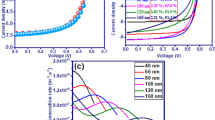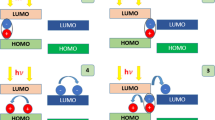Abstract
Hybrid solar cells (HSCs) can be a new pathway for low-cost, flexible, and high efficiency solar cells. III-V nanowires (NWs) with sub-wavelength scale dimensions have shown excellent optical and electrical properties, and can be easily fabricated on thin substrates together with polymer materials. In order to obtain optimal design requirements for III-V NWs/PEDOT: PSS HSCs, optical simulations using finite-difference-time-domain (FDTD) method is performed. To enhance light absorption properties of NWs, the important geometrical parameter, namely the diameter (D) of the NWs is optimized. Further, to maximize short-circuit current density, polymer (PEDOT: PSS) coating thickness on the NWs is optimized. In comparison to NW/air system, optimized PEDOT: PSS-coated NWs have shown better intrinsic anti-reflection properties, broad absorption spectra, and enhanced optical generation rates.
Access this chapter
Tax calculation will be finalised at checkout
Purchases are for personal use only
Similar content being viewed by others
References
Tsai M, Wei W, Tang L, Chang H, Tai S, Yang P, Lau SP, Chen L, He J (2015) Si hybrid solar cells with 13% Efficiency via concurrent improvement in optical and electrical properties by employing graphene quantum dots. https://doi.org/10.1021/acsnano.5b05928
Ong PL, Levitsky IA (2010) Organic/IV, III-V semiconductor hybrid solar cells. Energies 3:313–334. https://doi.org/10.3390/en3030313
Liu R (2014) Hybrid organic/inorganic nanocomposites for photovoltaic cells. Materials (Basel) 7:2747–2771. https://doi.org/10.3390/ma7042747
Abujetas DR, Paniagua-Domínguez R, Sánchez-Gil JA (2015) Unraveling the Janus role of mie resonances and leaky/guided modes in semiconductor nanowire absorption for enhanced light harvesting. ACS Photonics 2:921–929. https://doi.org/10.1021/acsphotonics.5b00112
Dayal S, Kopidakis N, Olson DC, Ginley DS, Rumbles G (2010) Photovoltaic devices with a low band gap polymer and CdSe nanostructures exceeding 3% efficiency. Nano Lett 10:239–242. https://doi.org/10.1021/nl903406s
Nicolaidis NC, Routley BS, Holdsworth JL, Belcher WJ, Zhou X, Dastoor PC (2011) Fullerene contribution to photocurrent generation in organic photovoltaic cells. J Phys Chem C 115:7801–7805. https://doi.org/10.1021/jp2007683
Kalita G, Adhikari S, Aryal HR, Afre R, Soga T, Sharon M, Koichi W, Umeno M (2009) Silicon nanowire array/polymer hybrid solar cell incorporating carbon nanotubes. p 115104. https://doi.org/10.1088/0022-3727/42/11/115104
Lu W, Wang C, Chen L (2011) Nanoscale Si/PEDOT : PSS core/shell nanowire arrays for efficient hybrid solar cells. pp 3631–3634. https://doi.org/10.1039/c1nr10629e
Sharma M, Pudasaini PR, Ruiz-zepeda F, Elam D, Ayon AA (2014) Ultrathin, flexible organic−inorganic hybrid solar cells based on silicon nanowires and PEDOT : PSS. ACS Appl Mater Interfaces 6:4356–4363. https://doi.org/10.1021/am500063w
Chao J-J, Shiu S-C, Hung S-C, Lin C-F (2010) GaAs nanowire/poly(3,4-ethylenedioxythiophene):poly(styrenesulfonate) hybrid solar cells. Nanotechnology 21:285203. https://doi.org/10.1088/0957-4484/21/28/285203
Sturmberg BCP, Dossou KB, Botten LC, Asatryan AA, Poulton CG, Mcphedran RC, Sterke CM (2014) De: simple semi-analytic approach
Prashant DV, Samajdar DP, Sharma D (2019) Optical simulation and geometrical optimization of P3HT/GaAs nanowire hybrid solar cells for maximal photocurrent generation via enhanced light absorption. Sol Energy 194:848–855. https://doi.org/10.1016/j.solener.2019.11.027
Moiz SA, Nahhas AM, Um H, Jee S, Cho HK, Kim S, Lee J (2012) A stamped PEDOT : PSS—silicon nanowire hybrid solar cell. p 145401. https://doi.org/10.1088/0957-4484/23/14/145401
Mariani G, Laghumavarapu RB, Villers BT, De, Shapiro J, Lin A, Schwartz BJ, Huffaker DL, Mariani G, Laghumavarapu RB, Villers BT De, Huffaker DL (2013) Hybrid conjugated polymer solar cells using patterned GaAs nanopillars Hybrid conjugated polymer solar cells using patterned GaAs nanopillars. 013107, pp 3–6. https://doi.org/10.1063/1.3459961
Khalil A, Ahmed Z, Touati F, Masmoudi M (2016) Review on organic solar cells. In: 13th international multi-conference on systems, signals & devices, SSD. pp 342–353. https://doi.org/10.1109/SSD.2016.7473760
Chao JJ, Shiu SC, Lin CF (2012) GaAs nanowire/poly(3,4-ethylenedioxythiophene):poly(styrenesulfonate) hybrid solar cells with incorporating electron blocking poly(3-hexylthiophene) layer. Sol Energy Mater Sol Cells 105:40–45. https://doi.org/10.1016/j.solmat.2012.05.021
Bi H, LaPierre RR (2009) A GaAs nanowire/P3HT hybrid photovoltaic device. Nanotechnology 20. https://doi.org/10.1088/0957-4484/20/46/465205
Srivastava A, Samajdar DP, Sharma D (2018) Plasmonic effect of different nanoarchitectures in the efficiency enhancement of polymer based solar cells: a review. Sol Energy 173:905–919. https://doi.org/10.1016/j.solener.2018.08.028
Zhang, S., Liu, M., Liu, W., Li, Z., Liu, Y., Wang, X., Yang, F.: High-efficiency photon capturing in ultrathin silicon solar cells with double-sided skewed nanopyramid arrays. J. Opt. (United Kingdom). 19, (2017). https://doi.org/10.1088/2040-8986/aa7ea1
Cao Z, Chen Z, Escoubas L (2014) Optical, structural, and electrical properties of PEDOT : PSS thin films doped with silver nanoprisms. 4: 3375–3384. https://doi.org/10.1364/OME.4.002525
Wu D, Tang X, Wang K, Li X (2017) An analytic approach for optimal geometrical design of GaAs nanowires for maximal light harvesting in photovoltaic cells. Sci Rep 7:1–8. https://doi.org/10.1038/srep46504
Wen L, Zhao Z, Li X, Shen Y, Guo H, Wang Y (2011) Theoretical analysis and modeling of light trapping in high efficiency GaAs nanowire array solar cells. Appl Phys Lett 99:2009–2012. https://doi.org/10.1063/1.3647847
Wang W, Li X, Wen L, Zhao Y, Duan H, Zhou B, Shi T, Zeng X, Li N, Wang Y (2014) Optical simulations of P3HT/Si nanowire array hybrid solar cells. Nanoscale Res Lett 9:1–6. https://doi.org/10.1186/1556-276X-9-238
Wu D, Tang X, Wang K, Li X (2016) Effective coupled optoelectrical design method for fully infiltrated semiconductor nanowires based hybrid solar cells. Opt Express 24:A1336. https://doi.org/10.1364/oe.24.0a1336
Acknowledgements
The authors are thankful to the Science and Engineering Research Board, Department of Science and Technology, Government of India (ECR/2017/002369) (Established through an Act of Parliament), for providing the financial support to carry out this work. This work has been implemented under the research project titled “Analytical Modelling and Simulation of III-V nanostructure based Hybrid Solar Cells” which is funded by this board.
Author information
Authors and Affiliations
Corresponding author
Editor information
Editors and Affiliations
Rights and permissions
Copyright information
© 2020 The Editor(s) (if applicable) and The Author(s), under exclusive license to Springer Nature Singapore Pte Ltd.
About this paper
Cite this paper
Prashant, D.V., Samajdar, D.P., Sachchidanand (2020). Optical Simulation of III-V Semiconductor Nanowires/PEDOT: PSS-Based Hybrid Solar Cells: Influence of Polymer Coating Thickness and Geometrical Parameters on Light Harvesting and Overall Photocurrent. In: Sikander, A., Acharjee, D., Chanda, C., Mondal, P., Verma, P. (eds) Energy Systems, Drives and Automations. Lecture Notes in Electrical Engineering, vol 664. Springer, Singapore. https://doi.org/10.1007/978-981-15-5089-8_34
Download citation
DOI: https://doi.org/10.1007/978-981-15-5089-8_34
Published:
Publisher Name: Springer, Singapore
Print ISBN: 978-981-15-5088-1
Online ISBN: 978-981-15-5089-8
eBook Packages: EnergyEnergy (R0)




